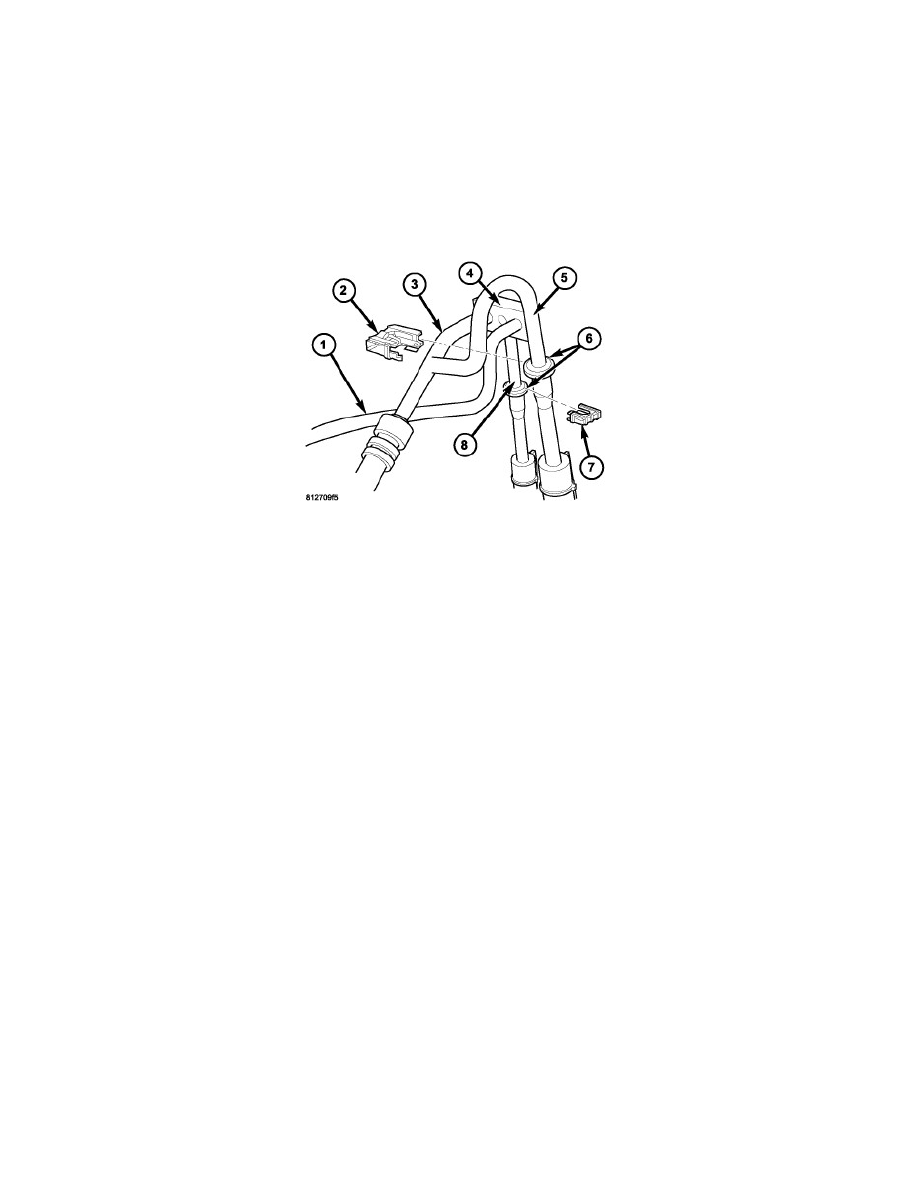Durango 2WD V8-5.7L Hybrid (2009)

operating instructions supplied by the equipment manufacturer for proper use and care of the refrigerant recovery/recycling and charging
equipment.
NOTE: When replacing multiple A/C system components, refer to the Refrigerant Oil Capacities chart to determine how much oil should be
added to the refrigerant system See: Heating and Air Conditioning/Specifications/Capacity Specifications/Refrigerant Oil Capacity .
NOTE: Replacement of the refrigerant line O-ring seals and gaskets is required anytime a refrigerant line is disconnected. Failure to replace
the rubber O-ring seals and metal gaskets could result in a refrigerant system leak.
NOTE: The A/C suction line connects between the A/C evaporator and the A/C compressor. On models equipped with the rear heating-A/C
system, the A/C suction line also includes an extension tube that connects the suction line to the underbody lines.
1. Install the A/C suction line (3) to the A/C compressor and the front A/C expansion valve See: A/C Suction Line - Installation.
2. Remove the tape or plugs from the refrigerant line coupler (6) and the underbody suction line.
3. Lubricate a new rubber O-ring seal with clean refrigerant oil and install it onto the refrigerant line coupler. Use only the specified O-ring as it is
made of a special material for the R-134a system. Use only refrigerant oil of the type recommended for the A/C compressor in the vehicle.
4. Connect the underbody suction line to the suction line extension tube (5) See: Heating and Air Conditioning/Coupler HVAC/Service and
Repair/Refrigerant Line Coupler - Installation.
5. Install the secondary retaining clip (2) onto the refrigerant line coupler.
WARNING: Always follow vehicle service procedures to properly connect batteries on an HEV model. Serious or fatal injury may result from
improper service procedures.
6. On HEV models, reconnect the battery system using the service disconnect at the battery pack See: Hybrid Drive Systems/Battery System,
Hybrid Drive/Service and Repair.
7. On gasoline only models, reconnect the negative battery cable.
8. Evacuate the refrigerant system See: Heating and Air Conditioning/Service and Repair/Refrigerant System Evacuate.
9. Adjust the refrigerant oil level See: Heating and Air Conditioning/Specifications/Capacity Specifications/Refrigerant Oil Capacity.
10. Charge the refrigerant system See: Heating and Air Conditioning/Service and Repair/Refrigerant System Charge.
A/C Underbody Lines - Removal
REMOVAL
WARNING: On vehicles equipped with the high voltage system, you must thoroughly read and follow all High Voltage Safety procedures. In
addition, before performing any diagnostic or service procedure near a high voltage component, you must perform the High
Voltage Power Down. Failure to follow these instructions may result in possible serious or fatal injury See: Hybrid Drive
Systems/Battery System, Hybrid Drive/Service Precautions
WARNING: Refer to the applicable warnings and cautions for this system before performing the following operation See: Heating and Air
Conditioning/Service Precautions/Warning and See: Heating and Air Conditioning/Service Precautions/Caution . Failure to follow the
warnings and cautions may result in possible serious or fatal injury.
CAUTION: Polyalkylene Glycol (PAG) oil can contaminate the refrigerant system of a Hybrid Electric Vehicle (HEV) and lead to A/C system
damage and failure. If the refrigerant recovery/recycling and charging equipment was last used on a non-HEV model, flush the
hoses of the equipment with a solvent approved by the equipment manufacturer before using the equipment on an HEV model, or
use refrigerant recovery/recycling and charging equipment designated only for HEV models by your service facility. See the
